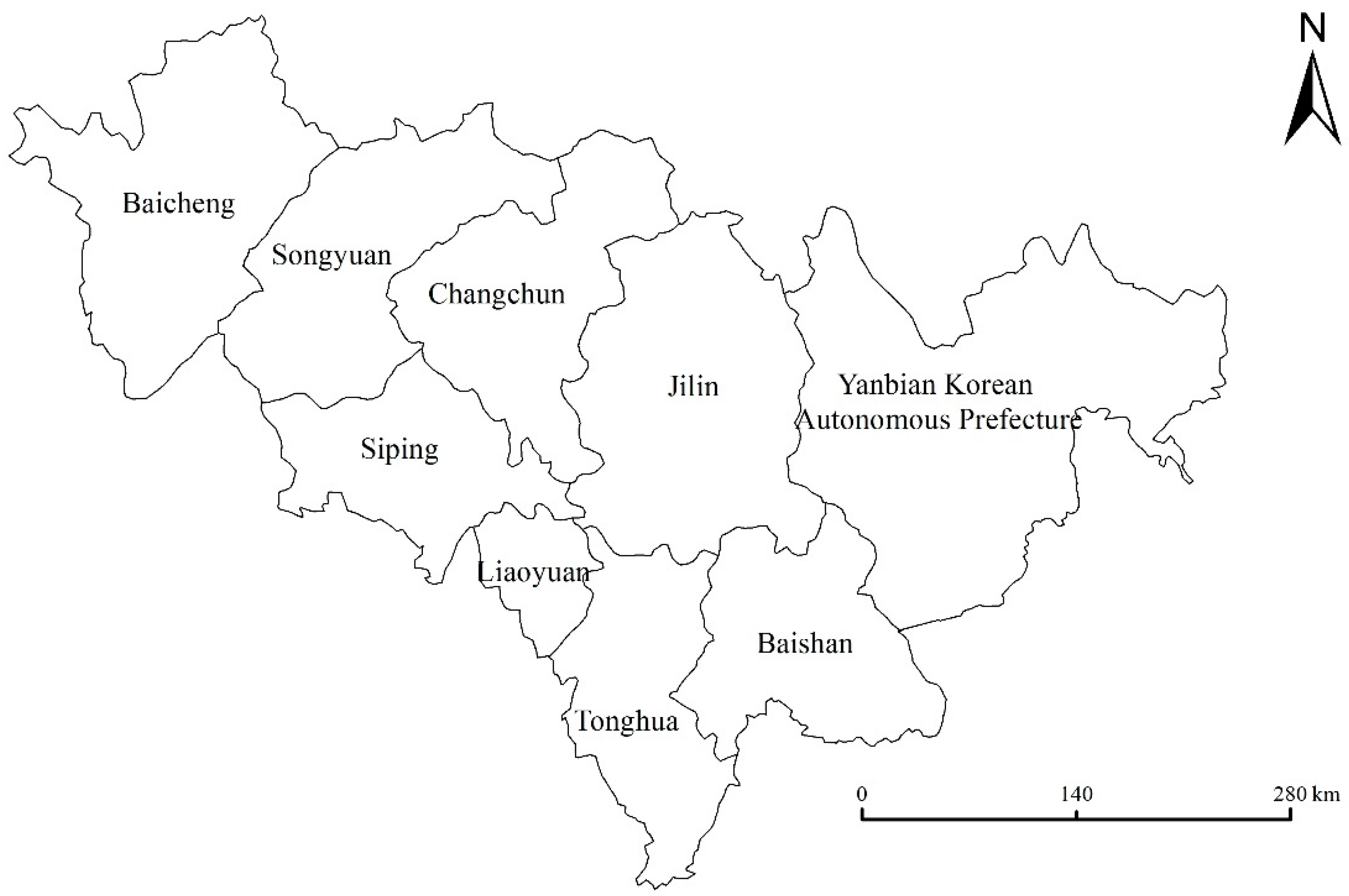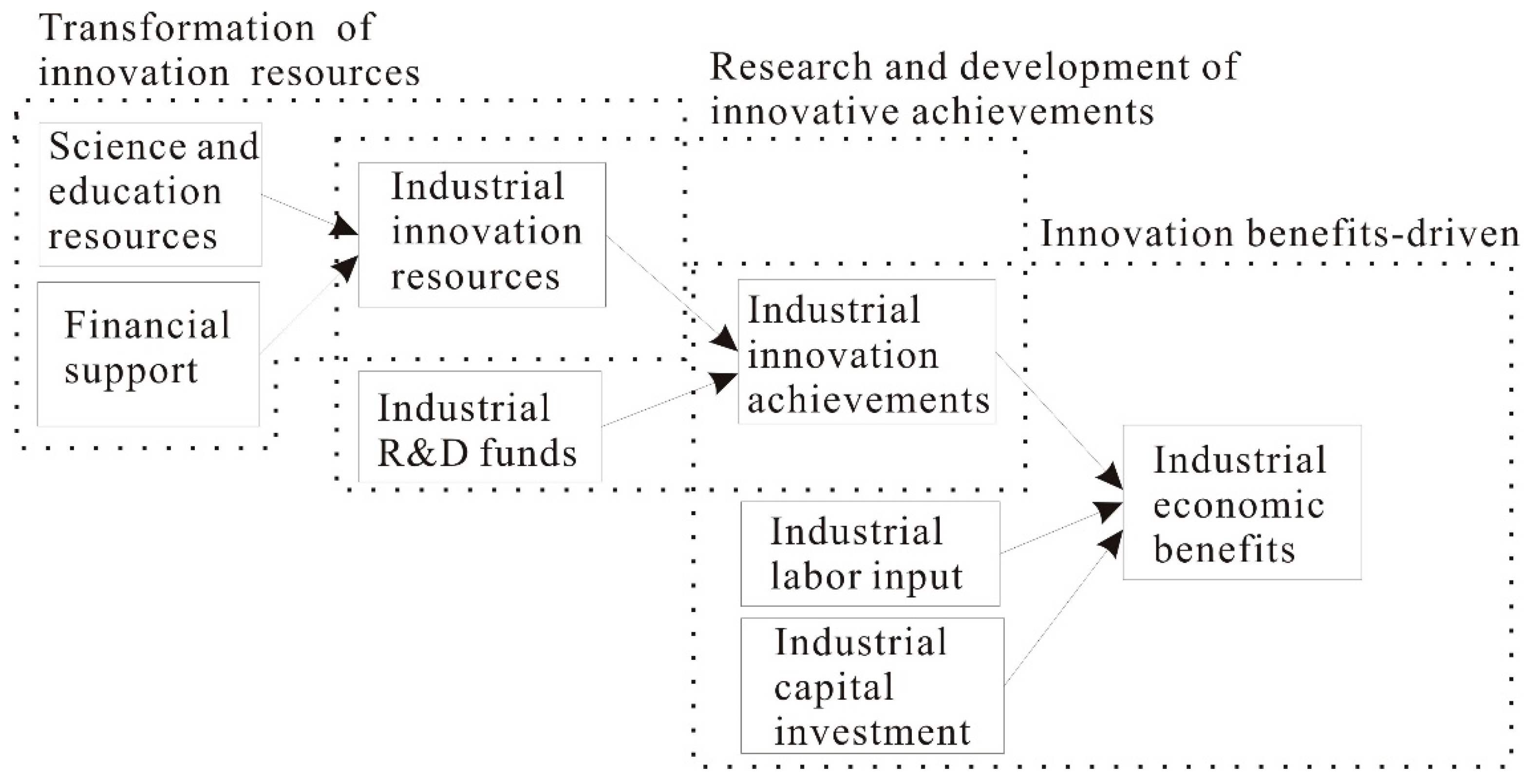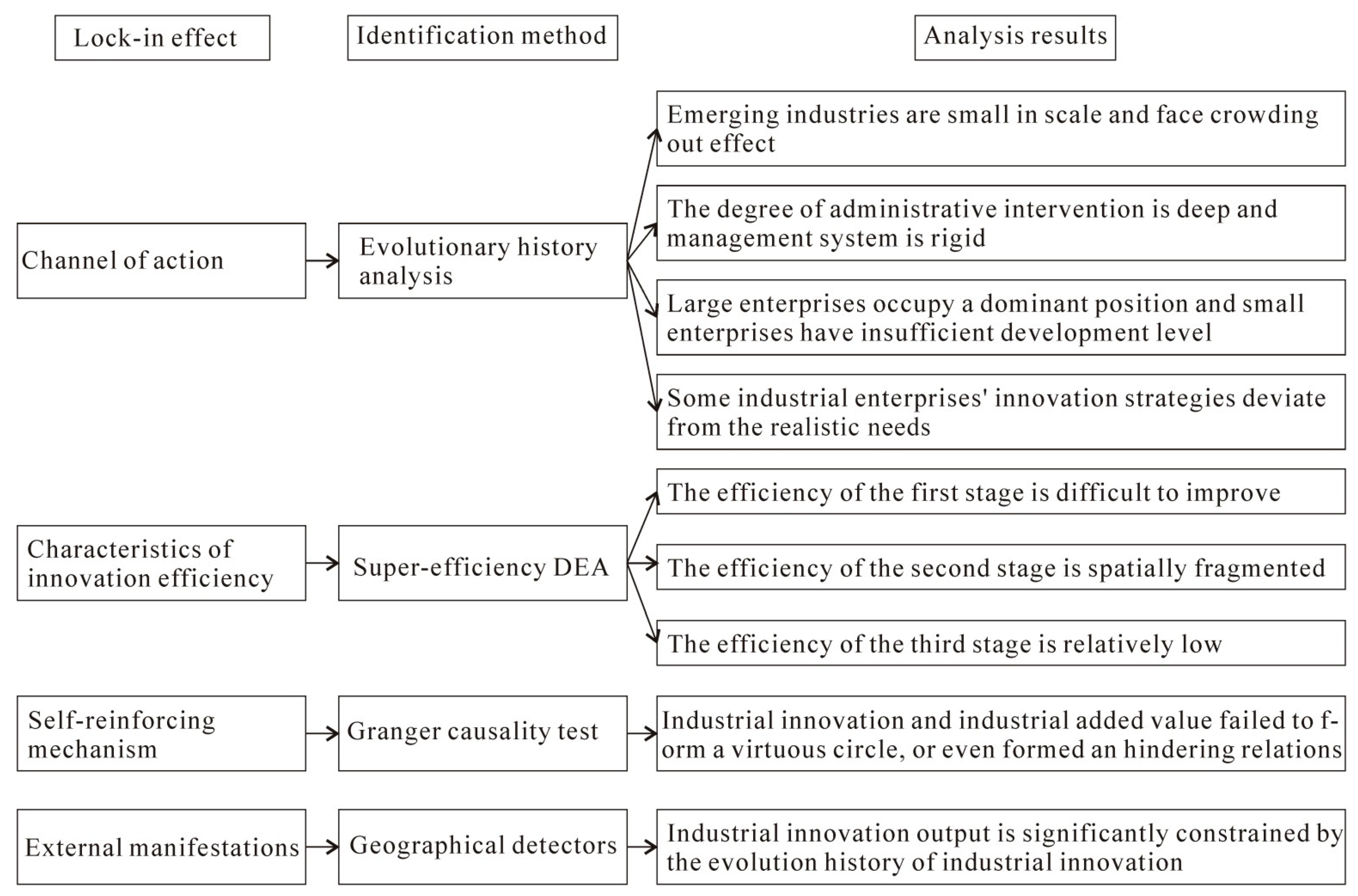Research on Industrial Innovation Efficiency and the Influencing Factors of the Old Industrial Base Based on the Lock-In Effect, a Case Study of Jilin Province, China
Abstract
1. Introduction
2. Theoretical Analysis Framework
2.1. Evolution of Industrial Innovation in Jilin Province
2.2. Three-Stage Industrial Innovation Efficiency Measurement
2.3. Expanded Porter Diamond Model
3. Materials and Methods
3.1. Data Sources
3.2. Model Approach
3.2.1. Super-Efficiency Data Envelopment Analysis
3.2.2. Granger Causality Test
3.2.3. Geographical Detectors
3.2.4. Panel Regression Analysis
4. Results
4.1. Three-Stage Industrial Innovation Efficiency
4.2. Identification of the Lock-In Effect
4.3. Empirical Analysis of Influencing Factors
5. Discussion
6. Conclusions and Advices
6.1. Conclusions
6.2. Policy Advice
Author Contributions
Funding
Institutional Review Board Statement
Informed Consent Statement
Data Availability Statement
Conflicts of Interest
References
- Tziogkidis, P.; Philippas, D.; Leontitsis, A.; Sickles, R.C. A data envelopment analysis and local partial least squares approach for identifying the optimal innovation policy direction. Eur. J. Oper. Res. 2020, 285, 1011–1024. [Google Scholar] [CrossRef]
- Aytekin, A.; Ecer, F.; Korucuk, S.; Karamaşa, C. Global innovation efficiency assessment of EU member and candidate countries via DEA-EATWIOS multi-criteria methodology. Technol. Soc. 2022, 68, 101896. [Google Scholar] [CrossRef]
- Bai, J. On regional innovation efficiency: Evidence from panel data of China’s different provinces. Reg. Stud. 2013, 47, 773–788. [Google Scholar] [CrossRef]
- Choi, H.; Zo, H. Assessing the efficiency of national innovation systems in developing countries. Sci. Public Policy 2019, 46, 530–540. [Google Scholar] [CrossRef]
- Li, H.; Pang, S.; Cao, Y.; Gao, J. Research on the evaluation of comprehensive efficiency of technological innovation and eco-environment in China. J. Clean Prod. 2021, 283, 124603. [Google Scholar] [CrossRef]
- Wang, K.; Bian, Y.; Cheng, Y. Exploring the Spatial Correlation Network Structure of Green Innovation Efficiency in the Yangtze River Delta, China. Sustainability 2022, 14, 3903. [Google Scholar] [CrossRef]
- Wu, F.; Fu, X.; Zhang, T.; Wu, D.; Sindakis, S. Examining Whether Government Environmental Regulation Promotes Green Innovation Efficiency—Evidence from China’s Yangtze River Economic Belt. Sustainability 2022, 14, 1827. [Google Scholar] [CrossRef]
- Li, H.; He, H.; Shan, J.; Cai, J. Innovation efficiency of semiconductor industry in China: A new framework based on generalized three-stage DEA analysis. Socio-Econ. Plan. Sci. 2019, 66, 136–148. [Google Scholar] [CrossRef]
- Broekel, T. Collaboration Intensity and Regional Innovation Efficiency in Germany—A Conditional Efficiency Approach. Ind. Innov. 2012, 19, 155–179. [Google Scholar] [CrossRef]
- Lai, H.; Shi, H.; Zhou, Y. Regional technology gap and innovation efficiency trap in Chinese pharmaceutical manufacturing industry. PLoS ONE 2020, 15, e0233093. [Google Scholar] [CrossRef] [PubMed]
- Zhu, W.; Li, D.; Han, L. Spatial–Temporal Evolution and Sustainable Type Division of Fishery Science and Technology Innovation Efficiency in China. Sustainability 2022, 14, 7277. [Google Scholar] [CrossRef]
- Haschka, R.E.; Herwartz, H. Innovation efficiency in European high-tech industries: Evidence from a Bayesian stochastic frontier approach. Res. Policy 2020, 49, 104054. [Google Scholar] [CrossRef]
- Miao, C.L.; Duan, M.M.; Zuo, Y.; Wu, X.Y. Spatial heterogeneity and evolution trend of regional green innovation efficiency--An empirical study based on panel data of industrial enterprises in China’s provinces. Energy Policy 2021, 156, 112370. [Google Scholar] [CrossRef]
- Han, Y.; Hua, M.; Huang, M.; Li, J.; Wang, S. Dynamic Transition and Convergence Trend of the Innovation Efficiency among Companies Listed on the Growth Enterprise Market in the Yangtze River Economic Belt—Empirical Analysis Based on DEA—Malmquist Model. Sustainability 2022, 14, 5269. [Google Scholar] [CrossRef]
- Hou, B.; Hong, J.; Wang, H.; Zhou, C. Academia-industry collaboration, government funding and innovation efficiency in Chinese industrial enterprises. Technol. Anal. Strateg. Manag. 2019, 31, 692–706. [Google Scholar] [CrossRef]
- Xu, K.; Loh, L.; Chen, Q. Sustainable innovation governance: An analysis of regional innovation with a super efficiency slack-based measure model. Sustainability 2020, 12, 3008. [Google Scholar] [CrossRef]
- Min, S.; Kim, J.; Sawng, Y.W. The effect of innovation network size and public R&D investment on regional innovation efficiency. Technol. Forecast. Soc. Chang. 2020, 155, 119998. [Google Scholar] [CrossRef]
- Lv, C.; Shao, C.; Lee, C.C. Green technology innovation and financial development: Do environmental regulation and innovation output matter? Energy Econ. 2021, 98, 105237. [Google Scholar] [CrossRef]
- Sun, X.; Zhou, X.; Chen, Z.; Yang, Y. Environmental efficiency of electric power industry, market segmentation and technological innovation: Empirical evidence from China. Sci. Total Environ. 2020, 706, 135749. [Google Scholar] [CrossRef]
- Garcia, B.C.; Chavez, D. Network-based innovation systems: A capital base for the Monterrey city-region, Mexico. Expert Syst. Appl. 2014, 41, 5636–5646. [Google Scholar] [CrossRef]
- Rohe, S.; Mattes, J. What about the regional level? Regional configurations of Technological Innovation Systems. Geoforum 2022, 129, 60–73. [Google Scholar] [CrossRef]
- Heindl, A.B. Separate frameworks of regional innovation systems for analysis in China? Conceptual developments based on a qualitative case study in Chongqing. Geoforum 2020, 115, 34–43. [Google Scholar] [CrossRef]
- Yongsheng, X.; Xiaolei, Z.; Wei, W. Coupling or lock-in? Co-evolution of cultural embeddness and cluster innovation-exploratory case study of Shaoxing textile cluster. Technol. Soc. 2021, 67, 101765. [Google Scholar] [CrossRef]
- Ghazinoory, S.; Sarkissian, A.; Farhanchi, M.; Saghafi, F. Renewing a dysfunctional innovation ecosystem: The case of the Lalejin ceramics and pottery. Technovation 2020, 96, 102122. [Google Scholar] [CrossRef]
- Zeller, C. The pharma-biotech complex and interconnected regional innovation arenas. Urban Stud. 2010, 47, 2867–2894. [Google Scholar] [CrossRef]
- Rutten, R. Openness values and regional innovation: A set-analysis. J. Econ. Geogr. 2019, 19, 1211–1232. [Google Scholar] [CrossRef]
- Xie, L.; Yang, Z.; Cai, J.; Cheng, Z.; Wen, T.; Song, T. Harbin: A rust belt city revival from its strategic position. Cities 2016, 58, 26–38. [Google Scholar] [CrossRef]
- Goch, S. Betterment without airs: Social, cultural, and political consequences of de-industrialization in the Ruhr. Int. Rev. Soc. Hist. 2002, 47, 87–111. [Google Scholar] [CrossRef]
- David, P.A. Clio and the Economics of QWERTY. Am. Econ. Rev. 1985, 75, 332–337. [Google Scholar]
- Arthur, W.B. Competing technologies, increasing returns and lock in by historic events. Econ. J. 1989, 99, 116–131. [Google Scholar] [CrossRef]
- North, D.C. Institutions, Institutional Change and Economic Performance; Cambridge University Press: Cambridge, UK, 1990. [Google Scholar]
- Grilltsch, M.; Sotarauta, M. Trinity of change agency, regional development paths and opportunity spaces. Prog. Hum. Geogr. 2020, 44, 704–723. [Google Scholar] [CrossRef]
- Hassink, R. Loced in decline? On the role of regional lock-ins in old industrial areas. In The Handbook of Evolutionary Economic Geography; Boschma, R., Martin, R., Eds.; Edward Elgar Publishing: London, UK, 2010; pp. 450–468. [Google Scholar]
- Martin, R.; Sunley, P. Path dependence and regional economic evolution. J. Econ. Geogr. 2006, 6, 395–437. [Google Scholar] [CrossRef]
- Best, M. The new competitive advantage: The renewal of American industry; Oxford University Press: New York, NY, USA, 2001. [Google Scholar]
- Scott, A.J. Entrepreneurship, innovation and industrial development: Geography and the creative field revisited. Small Bus. Econ. Group 2006, 26, 1–24. [Google Scholar] [CrossRef]
- Neffke, F.; Henning, M.; Boschma, R. How do regions diversify over time? Industry relatedness and the development of new growth paths in regions. Econ. Geogr. 2011, 87, 237–265. [Google Scholar] [CrossRef]
- Cho, M.; Hassink, R. Limits to locking-out through restructuring: The textile industry in Daegu, South Korea. Reg. Stud. 2009, 43, 1183–1198. [Google Scholar] [CrossRef]
- Jin, F.; Wang, J.; Yang, Y.; Ma, L.; Qi, Y. The Paths and Solutions of Innovation Development in Northeast China. Scientia Geographica Sinica 2016, 36, 1285–1292. (In Chinese) [Google Scholar] [CrossRef]
- Guan, H.; Liu, W.; Zhang, P.; Lo, K.; Li, J.; Li, L. Analyzing Industrial Structure Evolution of Old Industrial Cities Using Evolutionary Resilience Theory: A Case Study in Shenyang of China. Chin. Geogra. Sci. 2018, 28, 516–528. [Google Scholar] [CrossRef]
- Song, Z.Y.; Che, S.Y.; Wang, J.E. The Spatio-temporal Analysis of Regional Innovation Capacity and Its Economic Contribution in Northeast China. Scientia Geographica Sinica 2016, 36, 1388–1396. (In Chinese) [Google Scholar] [CrossRef]
- Zheng, W.F.; Sun, J.C. On the innovation drive and the revitalization of northeast old industrial base. Sci. Technol. Prog. Policy 2014, 31, 41–44. (In Chinese) [Google Scholar] [CrossRef]
- Carayannis, E.G.; Grigoroudis, E.; Goletsis, Y. A multilevel and multistage efficiency evaluation of innovation systems: A multiobjective DEA approach. Expert Syst. Appl. 2016, 62, 63–80. [Google Scholar] [CrossRef]
- Wang, Q.; Hang, Y.; Sun, L.; Zhao, Z. Two-stage innovation efficiency of new energy enterprises in China: A non-radial DEA approach. Technol. Forecast. Soc. Chang. 2016, 112, 254–261. [Google Scholar] [CrossRef]
- Etzkowitz, H. Triple helix clusters: Boundary permeability at university–industry–government interfaces as a regional innovation strategy. Environ. Plan C Gov. Policy 2012, 30, 766–779. [Google Scholar] [CrossRef]
- Ma, J. Developing Joint R&D Institutes between Chinese Universities and International Enterprises in China’s Innovation System: A Case at Tsinghua University. Sustainability 2019, 11, 7133. [Google Scholar] [CrossRef]
- Cantner, U.; Dettmann, E.; Giebler, A.; Guenther, J.; Kristalova, M. The impact of innovation and innovation subsidies on economic development in German regions. Reg. Stud. 2019, 53, 1284–1295. [Google Scholar] [CrossRef]
- Sung, B. Do government subsidies promote firm-level innovation? Evidence from the Korean renewable energy technology industry. Energy Policy 2019, 132, 1333–1344. [Google Scholar] [CrossRef]
- Porter, M.E. Clusters and the New Economics of Competition; Harvard Business Review: Boston, MA, USA, 1998. [Google Scholar]
- Fang, K.; Zhou, Y.; Wang, S.; Ye, R.; Guo, S. Assessing national renewable energy competitiveness of the G20: A revised Porter’s Diamond Model. Renew. Sust. Energ. Rev. 2018, 93, 719–731. [Google Scholar] [CrossRef]
- Adler, P.; Florida, R. Geography as strategy: The changing geography of corporate headquarters in post-industrial capitalism. Reg. Stud. 2019, 54, 610–620. [Google Scholar] [CrossRef]
- Knight, E.; Kumar, V.; Wójcik, D.; O’Neil, P. The competitive advantage of regions: Economic geography and strategic management intersections. Reg. Stud. 2020, 54, 591–595. [Google Scholar] [CrossRef]
- Liu, C.; Gao, X.; Ma, W.; Chen, X. Research on regional differences and influencing factors of green technology innovation efficiency of China’s high-tech industry. J. Comput. Appl. Math. 2020, 369, 112597. [Google Scholar] [CrossRef]
- Liu, J.; Lu, K.; Cheng, S. International R&D Spillovers and Innovation Efficiency. Sustainability 2018, 10, 3974. [Google Scholar] [CrossRef]
- Yang, F.; Cheng, Y.; Yao, X. Influencing factors of energy technical innovation in China: Evidence from fossil energy and renewable energy. J. Clean Prod. 2019, 232, 57–66. [Google Scholar] [CrossRef]
- Xu, S.; Lu, B.B.; Yue, Q.D. Impact of sci-tech finance on the innovation efficiency of China’s marine industry. Mar. Pol. 2021, 133, 104708. [Google Scholar] [CrossRef]
- Charnes, A.; Cooper, W.W.; Rhodes, E. Measuring the efficiency of decision making units. Eur. J. Oper. Res. 1978, 2, 429–444. [Google Scholar] [CrossRef]
- Shi, X.; Xu, Y. Evaluation of China’s pilot low-carbon city program: A perspective of industrial carbon emission efficiency. Atmos. Pollut. Res. 2022, 13, 101446. [Google Scholar] [CrossRef]
- Yang, X.; Wang, W.; Wu, H.; Wang, J.; Ran, Q.; Ren, S. The impact of the new energy demonstration city policy on the green total factor productivity of resource-based cities: Empirical evidence from a quasi-natural experiment in China. J. Environ. Plan. Manag. 2021, 1–34. [Google Scholar] [CrossRef]
- Wang, J.; Wang, W.; Ran, Q.; Irfan, M.; Ren, S.; Yang, X.; Wu, H.; Ahmad, M. Analysis of the mechanism of the impact of internet development on green economic growth: Evidence from 269 prefecture cities in China. Environ. Sci. Pollut. Res. 2022, 29, 9990–10004. [Google Scholar] [CrossRef]
- Liu, C.; Cui, L.; Li, C. Impact of environmental regulation on the green total factor productivity of dairy farming: Evidence from China. Sustainability 2022, 14, 7274. [Google Scholar] [CrossRef]
- Feng, J.; Wang, N.; Sun, G. Measurement of Innovation-Driven Development Performance of Large-Scale Environmental Protection Enterprises Investing in Public–Private Partnership Projects Based on the Hybrid Method. Sustainability 2022, 14, 5096. [Google Scholar] [CrossRef]
- Liu, P.; Zhang, L.; Tarbert, H.; Yan, Z. Analysis on spatio-temporal characteristics and influencing factors of industrial green innovation efficiency—From the perspective of innovation value chain. Sustainability 2021, 14, 342. [Google Scholar] [CrossRef]
- Xu, Z.; Zhu, X.; Wei, G.; Ouyang, X. Spatio-Temporal Evolution and Mechanism Analysis of China’s Regional Innovation Efficiency. Sustainability 2021, 13, 11089. [Google Scholar] [CrossRef]
- Alidrisi, H.; Aydin, M.E.; Bafail, A.O.; Abdulal, R.; Karuvatt, S.A. Monitoring the performance of petrochemical organizations in Saudi Arabia using data envelopment analysis. Mathematics 2019, 7, 519. [Google Scholar] [CrossRef]
- Sojoodi, S.; Dastmalchi, L.; Neshat, H. Efficiency ranking of different types of power plants in Iran using super efficiency method. Energy 2021, 233, 121104. [Google Scholar] [CrossRef]
- Granger, C.W.J. Investigating causal relations by econometric models and cross-spectral methods. Econometrica 1969, 37, 424–438. [Google Scholar] [CrossRef]
- Wang, J.F.; Li, X.H.; Christakos, G.; Liao, Y.L.; Zhang, T.; Gu, X.; Zheng, X.Y. Geographical detectorsctorsectorsrs, Y.L.;ssessment and its application in the neural tube defects study of the Heshun Region, China. Int. J. Geogr. Inf. Sci. 2010, 24, 107–127. [Google Scholar] [CrossRef]
- Wang, J.F.; Xu, C.D. Geographic detectors: Principles and prospects. Acta. Geogr. Sin. 2017, 72, 116–134. (In Chinese) [Google Scholar] [CrossRef]
- Liu, C.L.; Niu, C.C. Spatial evolution and influencing factors of inter-city technology transfer network in three provinces of northeast China. Acta. Geogr. Sin. 2019, 74, 2092–2107. (In Chinese) [Google Scholar] [CrossRef]







| Innovation Stage | Input Indicators | Output Indicators |
|---|---|---|
| Transformation of innovation resources | Number of universities and colleges (unit) | R&D personnel in industrial enterprises (person) |
| Number of full-time teachers in universities and colleges (person) | ||
| Local science and technology financial expenditure (10,000 yuan) | ||
| Local education expenditure (10,000 yuan) | ||
| Research and development of innovative achievements | R&D personnel in industrial enterprises (person) | Number of patent applications of industrial enterprises (item) |
| Internal expenditure of industrial R&D (10,000 yuan) | ||
| Innovation benefits-driven | Total industrial assets (10,000 yuan) | Industrial added value (10,000 yuan) |
| Annual average number of all employees (person) | ||
| Number of patent applications of industrial enterprises (item) |
| Element Layer | Index Layer | Computing Method |
|---|---|---|
| Demand situation | Gross domestic product (GDP) | The final result of production activities of all permanent residents in a certain region within a certain period of time |
| Dependence on foreign trade (DFT) | Total imports and exports/GDP | |
| Related industries | Proportion of tertiary industry output value (PTO) | Tertiary industry added value/GDP |
| Employment proportion of information and scientific research practitioners (EIS) | Information and scientific research employment/Urban unit employment | |
| Enterprise Strategy | Average expenditure on new products development (AEN) | Expenditure for new product development of industrial enterprises/Number of new product development projects |
| Trend of technological transformation (TTT) | Expenditure on technology acquisition and transformation of industrial enterprises/R&D internal expenditure | |
| Policy support | Total financial expenditure (TFE) | Local public financial expenditure |
| Proportion of science and technology financial expenditure (PST) | Science and technology financial expenditure/Local public financial expenditure | |
| Cluster structure | Average asset size of industrial enterprises (AIE) | Total assets of industrial enterprises/Number of industrial enterprises |
| The extent to which industrial enterprises save human resources (EEH) | Number of industrial enterprises/Number of industrial employees |
| Element Layer | Index Layer | Parameter Estimate | p Value |
|---|---|---|---|
| Intercept term | Intercept term ** | 3.70 × 10−1 | 0.017 |
| Demand situation | GDP ** | −1.25 × 10−8 | 0.020 |
| DFT * | 3.56 × 10−3 | 0.054 | |
| Related industries | PTO * | −7.10 × 10−3 | 0.076 |
| EIS | −2.44 × 10−4 | 0.859 | |
| Enterprise Strategy | AEN ** | −7.16 × 10−5 | 0.018 |
| TTT *** | 3.71 × 10−6 | 0.000 | |
| Policy support | TFE ** | 1.08 × 10−7 | 0.020 |
| PST | −5.35 × 10−2 | 0.163 | |
| Cluster structure | AIE | 2.52 × 10−7 | 0.520 |
| EEH ** | 3.09 × 10−2 | 0.017 |
Publisher’s Note: MDPI stays neutral with regard to jurisdictional claims in published maps and institutional affiliations. |
© 2022 by the authors. Licensee MDPI, Basel, Switzerland. This article is an open access article distributed under the terms and conditions of the Creative Commons Attribution (CC BY) license (https://creativecommons.org/licenses/by/4.0/).
Share and Cite
Li, Y.; Ma, Y. Research on Industrial Innovation Efficiency and the Influencing Factors of the Old Industrial Base Based on the Lock-In Effect, a Case Study of Jilin Province, China. Sustainability 2022, 14, 12739. https://doi.org/10.3390/su141912739
Li Y, Ma Y. Research on Industrial Innovation Efficiency and the Influencing Factors of the Old Industrial Base Based on the Lock-In Effect, a Case Study of Jilin Province, China. Sustainability. 2022; 14(19):12739. https://doi.org/10.3390/su141912739
Chicago/Turabian StyleLi, Yunyao, and Yanji Ma. 2022. "Research on Industrial Innovation Efficiency and the Influencing Factors of the Old Industrial Base Based on the Lock-In Effect, a Case Study of Jilin Province, China" Sustainability 14, no. 19: 12739. https://doi.org/10.3390/su141912739
APA StyleLi, Y., & Ma, Y. (2022). Research on Industrial Innovation Efficiency and the Influencing Factors of the Old Industrial Base Based on the Lock-In Effect, a Case Study of Jilin Province, China. Sustainability, 14(19), 12739. https://doi.org/10.3390/su141912739






